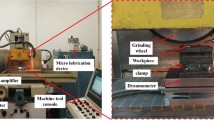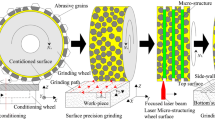Abstract
In the scenario of the modern manufacturing process, with the current demand for products and processes that require high-tech technology, the performance of a component is of great interest. In surface engineering, for example, the structured surface could significantly affect performance improvements. Micro- and nano-scale surface roughness plays the main role in the structured surfaces by determining the kinematics involved in this event. Among various features, the hydrophobic structured surface as a tribo-surface has found extensive applications, including drag reduction, improving heat transfer, anti-corrosion properties (anti-fogging and anti-icing), oil–water separation membrane, freshwater production, etc. Nevertheless, most available methods are two-step, complex, expensive, and questionable in terms of human health. In the present study, a new grinding method was proposed to manufacture structured surfaces with hydrophobic properties and drag reduction. The random distribution of the diamond particles was arranged on the wheel surface. They were placed in the predetermined location by a drilled thin polyethylene mask and a neodymium magnet as a non-contact external fixture. The Scanning Electron Microscope images revealed that the modified wheel resulted in a structured surface with continuous and discontinuous scratches. Shark skin texture as a unique topography was obtained by changing the cutting parameters. The results of the drag test showed that it was reduced by 20 to 30% for the Reynolds of 400 to 800. Changing the surface wetting regime from hydrophilicity to hydrophobicity was the main reason for drag reduction of the structured surfaces compared to the unstructured ones. According to the experiments, the contact angle improvement of the structured sample was around 361%. The formation of accumulated materials on the surface peaks during ductile material removal increased the scratch real depth from its nominal value. This phenomenon led to development of large air pads into scratches, which enhanced the hydrophobicity.
Graphical abstract























Similar content being viewed by others
Availability of data and material
The authors confirm that the data supporting the findings of this study are available within the article [and/or] its supplementary materials.
Code availability
Not applicable.
References
Guo B, Zhao Q (2015) Mechanical truing of V-shape diamond wheels for micro-structured surface grinding. Int J Adv Manuf Technol 78:1067–1073. https://doi.org/10.1007/s00170-014-6721-7
Patel D, Jain V, Ramkumar J (2016) Micro texturing on metallic surfaces: state of the art. Proc Inst Mech Eng Part B J Eng Manuf 232(6):941–964. https://doi.org/10.1177/0954405416661583
Obilor AF, Pacella M, Wilson A et al (2022) Micro-texturing of polymer surfaces using lasers: a review. Int J Adv Manuf Technol 120:103–135. https://doi.org/10.1007/s00170-022-08731-1
Jafari R, Cloutier C, Allahdini A et al (2019) Recent progress and challenges with 3D printing of patterned hydrophobic and superhydrophobic surfaces. Int J Adv Manuf Technol 103:1225–1238. https://doi.org/10.1007/s00170-019-03630-4
Shi Z, Wang Q, Li X et al (2022) Utilization of super-hydrophobic steel slag in mortar to improve water repellency and corrosion resistance. J Clean Prod 341:130783. https://doi.org/10.1016/j.jclepro.2022.130783
Kong L, Cheung Ch, To S (2012) Design, fabrication and characterization of three-dimensional patterned microstructured surfaces with self-cleaning properties from hydrophilic materials. Proc Inst Mech Eng Part B J Eng Manuf 226(9):1536–1549. https://doi.org/10.1177/0954405412447483
Li K, Fu P, Tang D et al (2018) Electron beam processed surface textures on titanium alloys for fluid-drag reduction. Int J Adv Manuf Technol 96:1553–1562. https://doi.org/10.1007/s00170-017-0619-0
Liu Y, Zhao Zh, Shao Y et al (2022) Preparation of a superhydrophobic coating based on polysiloxane modified SiO2 and study on its anti-icing performance. Surf Coat Technol 437:128359. https://doi.org/10.1016/j.surfcoat.2022.128359
Yang H, Jin K, Wang H et al (2022) Facile preparation of a high-transparency zwitterionic anti-fogging poly(SBMA-co-IA) coating with self-healing property. Prog Org Coat 165:106764. https://doi.org/10.1016/j.porgcoat.2022.106764
Moon I, Lee H, Oh Y et al (2019) Characterization of microfibril development on PTFE surface during hot imprinting process and its application for oil–water separation. Int J Adv Manuf Technol 102:1871–1883. https://doi.org/10.1007/s00170-019-03303-2
Li M, Qu J, Oclon P et al (2020) 3D numerical simulation of condensation and condensate behaviors on textured structures using lattice Boltzmann method. Int J Heat Mass Transf 160:120198. https://doi.org/10.1016/j.ijheatmasstransfer.2020.120198
Tangwarodomnukun V, Kringram S, Zhu H et al (2021) Fabrication of superhydrophobic surface on AISI316L stainless steel using a nanosecond pulse laser. Proc Inst Mech Eng Part B J Eng Manuf 236:680–693. https://doi.org/10.1177/09544054211040682
Qu L, Rahimi S, Qian J (2021) Preparation and characterization of hydrophobic coatings on wood surfaces by a sol-gel method and post-aging heat treatment. Polym Degrad Stab 183:109429. https://doi.org/10.1016/j.polymdegradstab.2020.109429
Jia P, Umezaki R, Murata J (2022) Direct micropatterning on a titanium surface through electrochemical imprint lithography with a polymer electrolyte membrane stamp. Microelectron Eng 257:111752. https://doi.org/10.1016/j.mee.2022.111752
Liu F, Han Y, Guo X et al (2021) Adhesion and machining performance of PVD AlCrN coatings with an ion beam/laser textured substrate. Surf Coat Technol 423:127607. https://doi.org/10.1016/j.surfcoat.2021.127607
Pei M, Huo L et al (2020) Hydrophobic surface via coating fluorinated homopolymer: effects of the surface etching of silicon wafer and coated fluoropolymer amount. Colloids Surf A 585:123984. https://doi.org/10.1016/j.colsurfa.2019.123984
Musavi SH, Davoodi B, Nankali M (2021) Assessment of tool wear and surface integrity in ductile cutting using a developed tool. Arab J Sci Eng 46:7773–7787. https://doi.org/10.1007/s13369-021-05560-4
Musavi SH, Sepehrikia M, Davoodi B (2022) Performance analysis of developed micro-textured cutting tool in machining aluminum alloy 7075–T6: assessment of tool wear and surface roughness. Int J Adv Manuf Technol 119:3343–3362. https://doi.org/10.1007/s00170-021-08349-9
Zhang J, Zhang Y, Yong J et al (2022) Femtosecond laser direct weaving bioinspired superhydrophobic/hydrophilic micro-pattern for fog harvesting. Opt Laser Technol 146:107593. https://doi.org/10.1016/j.optlastec.2021.107593
He W, Yao P, Chu D et al (2022) Controllable hydrophilic titanium surface with micro-protrusion or micro-groove processed by femtosecond laser direct writing. Opt Laser Technol 152:108082. https://doi.org/10.1016/j.optlastec.2022.108082
Zhao J, Guo J, Shrotriya P et al (2019) A rapid one-step nanosecond laser process for fabrication of super-hydrophilic aluminum surface. Opt Laser Technol 117:134–141. https://doi.org/10.1016/j.optlastec.2019.04.015
Cao Q, Wang Zh, He W, Guan Y (2021) Fabrication of super hydrophilic surface on alumina ceramic by ultrafast laser microprocessing. Appl Surf Sci 557:149842. https://doi.org/10.1016/j.apsusc.2021.149842
Young TJ, Jackson J, Roy S (2017) Tribological behavior and wettability of spray-coated superhydrophobic coatings on aluminum. Wear 376:1713–1719. https://doi.org/10.1016/j.wear.2016.12.050
Sutha S, Suresh S, Raj B (2017) Transparent alumina based superhydrophobic self-cleaning coatings for solar cell cover glass applications. Solar Energy Mater 165:128–137. https://doi.org/10.1016/j.solmat.2017.02.027
Wang B, Hua Y et al (2017) Transparent superhydrophobic solar glass prepared by fabricating groove-shaped arrays on the surface. Appl Surf Sci 426:957–964. https://doi.org/10.1016/j.apsusc.2017.07.169
Ahsan MS, Dewanda F et al (2013) Formation of superhydrophobic soda-lime glass surface using femtosecond-laser pulses. Appl Surf Sci 265:784–789. https://doi.org/10.1016/j.apsusc.2012.11.112
Hong Z, Wang W, Ma Z et al (2022) Anti-icing ceramics surface induced by femtosecond laser. Ceram Int 48(7):10236–10243. https://doi.org/10.1016/j.ceramint.2021.12.238
Rong W, Zhang H, Mao Zh et al (2021) Stable drag reduction of anisotropic superhydrophobic/hydrophilic surfaces containing bioinspired micro/nanostructured arrays by laser ablation. Colloids Surf A 622:126712. https://doi.org/10.1016/j.colsurfa.2021.126712
Xin G, Wu C et al (2021) Anti-corrosion superhydrophobic surfaces of Al alloy-based on micro-protrusion array structure fabricated by laser direct writing. J Alloy Compd 881:160649. https://doi.org/10.1016/j.jallcom.2021.160649
Xiang Y, He Y et al (2021) Superhydrophobic LDH/TTOS composite surface based on microstructure for the anti-corrosion, anti-fouling and oil-water separation application. Colloids Surf A 622:126558. https://doi.org/10.1016/j.colsurfa.2021.126558
Khodaii J, Adibi H, Barazandeh F et al (2020) Improvement of surface integrity in the grinding of bioceramic partially stabilized zirconia using analytical, numerical, and experimental methods 46:13784–13797. https://doi.org/10.1016/j.ceramint.2020.02.168
Hatami O, Adibi H, Rezaei SM (2022) Evaluation of the grinding process utilizing an auxiliary compressed air jet on cleaning the grinding wheel surface. Proc Inst Mech Eng Part E J Process Mech Eng. https://doi.org/10.1177/09544089221109835
Musavi SH, Adibi H, Rezaei SM (2022) Development of an innovative grinding process for producing functional surfaces. Tribol Int 173:107652. https://doi.org/10.1016/j.triboint.2022.107652
Esmaeili H, Adibi H, Rezaei SM (2021) Study on surface integrity and material removal mechanism in eco-friendly grinding of Inconel 718 using numerical and experimental investigations. Int J Adv Manuf Technol 112:1797–1818. https://doi.org/10.1007/s00170-020-06528-8
Mahmoudi SM, Mansouri Rad M, Ochbelagh DR (2021) Hybrid of the fuzzy logic controller with the harmony search algorithm to PWR in-core fuel management optimization. Nucl Eng Technol 53(11):3665–3674. https://doi.org/10.1016/j.net.2021.05.011
Naserbegi A, Aghaie M, Mahmoudi SM (2020) PWR core pattern optimization using grey wolf algorithm based on artificial neural network. Prog Nucl Energy 129:103505. https://doi.org/10.1016/j.pnucene.2020.103505
Musavi SH, Davoodi B, Niknam SA (2019) Effects of reinforced nanofluid with nanoparticles on cutting tool wear morphology. J Cent South Univ 26:1050–1064. https://doi.org/10.1007/s11771-019-4070-2
Musavi SH, Davoodi B, Niknam SA (2018) Environmental-friendly turning of A286 superalloy. J Manuf Process 32:734–743. https://doi.org/10.1016/j.jmapro.2018.04.005
Hatami O, Adibi H, Rezaei SM (2022) Application of a compressed air jet for cleaning of wheel surface in grinding nickel-based super alloy Inconel 718. CIRP J Manuf Sci Technol 37:233–244. https://doi.org/10.1016/j.cirpj.2022.02.004
Gao T, Li Ch, Zhang Y et al (2019) Dispersing mechanism and tribological performance of vegetable oil-based CNT nanofluids with different surfactants. Tribol Int 131:51–63. https://doi.org/10.1016/j.triboint.2018.10.025
Yuan Y, Zhang W, Fan X et al (2021) Porous grinding wheels toward alleviating the pre-fatigue and increasing the material removal efficiency for rail grinding. Tribol Int 154:106692. https://doi.org/10.1016/j.triboint.2020.106692
Musavi SH, Davoodi B, Eskandari B (2019) Pre-cooling intensity effects on cooling efficiency in cryogenic turning. Arab J Sci Eng 44:10389–10396. https://doi.org/10.1007/s13369-019-04056-6
Musavi SH, Davoodi B (2021) Risk assessment for hazardous lubricants in machining industry. Environ Sci Pollut Res 28:625–634. https://doi.org/10.1007/s11356-020-10472-1
Wang X, Li C, Zhang Y et al (2022) Influence of texture shape and arrangement on nanofluid minimum quantity lubrication turning. Int J Adv Manuf Technol 119:631–646. https://doi.org/10.1007/s00170-021-08235-4
Musavi SH, Davoodi B, Niknam SA (2021) Eco-green machining of superalloy A286: assessment of tool wear morphology and surface topology. Proc Inst Mech Eng Part B J Eng Manuf 235(9):1412–1424. https://doi.org/10.1177/0954405421995618
Zhang D, Zhang X, Nie G et al (2021) In situ imaging based thermo-mechanical analysis of built-up edge in cutting process. J Manuf Process 71:450–460. https://doi.org/10.1016/j.jmapro.2021.09.040
Musavi SH, Davoodi B, Eskandari B (2020) Evaluation of surface roughness and optimization of cutting parameters in turning of AA2024 alloy under different cooling-lubrication conditions using RSM method. J Cent South Univ 27:1714–1728. https://doi.org/10.1007/s11771-020-4402-2
Author information
Authors and Affiliations
Contributions
The research results in this work were presented in the Ph.D. thesis of Mr. Musavi. S.H. Musavi designed and performed experiments, analyzed data, and wrote the paper. Dr. Adibi and Dr. Rezaei also acted as the supervisors of Mr. Musavi. All authors have read and agreed to the published version of the manuscript.
Corresponding author
Ethics declarations
Ethics approval
Not applicable.
Consent to participate
Not applicable.
Consent for publication
All authors permit the publisher to publish the work.
Conflict of interest
The authors declare no competing interests.
Additional information
Publisher's Note
Springer Nature remains neutral with regard to jurisdictional claims in published maps and institutional affiliations.
Highlights
• A new technique for manufacturing structured grinding wheels with diamond abrasive particles was proposed.
• Tribological surfaces were manufactured by grinding technique with continuous and discontinuous scratches.
• Up to 30% improvement was recorded in the drag reduction for the structured surface.
• Up to 360% improvement was recorded in the hydrophobicity for the structured surface.
• Over time, the tribological properties of the surface have not decreased significantly, which indicates the durable properties of the produced surfaces.
Rights and permissions
Springer Nature or its licensor holds exclusive rights to this article under a publishing agreement with the author(s) or other rightsholder(s); author self-archiving of the accepted manuscript version of this article is solely governed by the terms of such publishing agreement and applicable law.
About this article
Cite this article
Musavi, S.H., Adibi, H. & Rezaei, S.M. Manufacturing of durable tribological surface by grinding process. Int J Adv Manuf Technol 122, 3393–3410 (2022). https://doi.org/10.1007/s00170-022-10104-7
Received:
Accepted:
Published:
Issue Date:
DOI: https://doi.org/10.1007/s00170-022-10104-7




